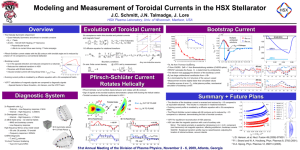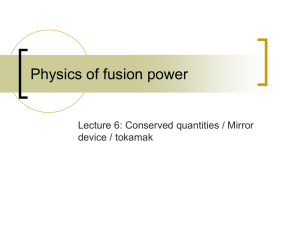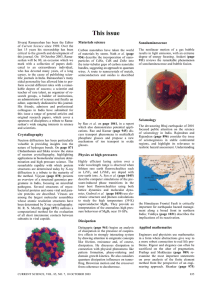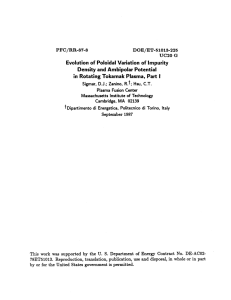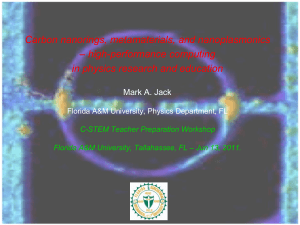On the Purpose of Toroidal Motion in a Convecting Mantle
advertisement
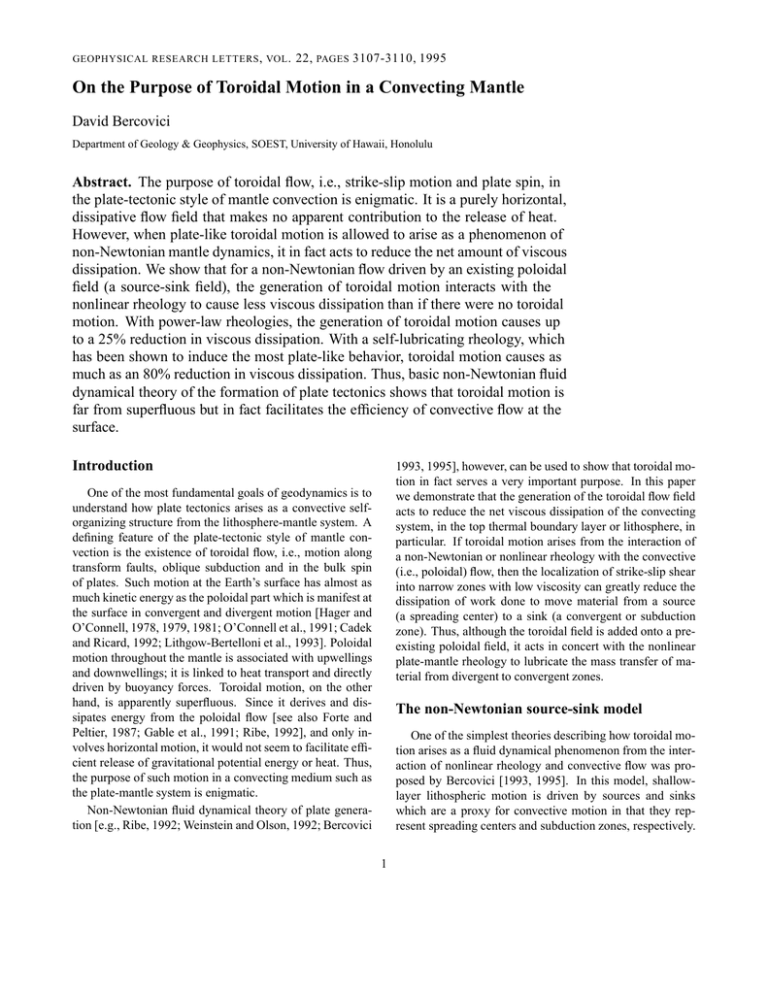
GEOPHYSICAL RESEARCH LETTERS , VOL . 22, PAGES 3107-3110, 1995 On the Purpose of Toroidal Motion in a Convecting Mantle David Bercovici Department of Geology & Geophysics, SOEST, University of Hawaii, Honolulu Abstract. The purpose of toroidal flow, i.e., strike-slip motion and plate spin, in the plate-tectonic style of mantle convection is enigmatic. It is a purely horizontal, dissipative flow field that makes no apparent contribution to the release of heat. However, when plate-like toroidal motion is allowed to arise as a phenomenon of non-Newtonian mantle dynamics, it in fact acts to reduce the net amount of viscous dissipation. We show that for a non-Newtonian flow driven by an existing poloidal field (a source-sink field), the generation of toroidal motion interacts with the nonlinear rheology to cause less viscous dissipation than if there were no toroidal motion. With power-law rheologies, the generation of toroidal motion causes up to a 25% reduction in viscous dissipation. With a self-lubricating rheology, which has been shown to induce the most plate-like behavior, toroidal motion causes as much as an 80% reduction in viscous dissipation. Thus, basic non-Newtonian fluid dynamical theory of the formation of plate tectonics shows that toroidal motion is far from superfluous but in fact facilitates the efficiency of convective flow at the surface. Introduction 1993, 1995], however, can be used to show that toroidal motion in fact serves a very important purpose. In this paper we demonstrate that the generation of the toroidal flow field acts to reduce the net viscous dissipation of the convecting system, in the top thermal boundary layer or lithosphere, in particular. If toroidal motion arises from the interaction of a non-Newtonian or nonlinear rheology with the convective (i.e., poloidal) flow, then the localization of strike-slip shear into narrow zones with low viscosity can greatly reduce the dissipation of work done to move material from a source (a spreading center) to a sink (a convergent or subduction zone). Thus, although the toroidal field is added onto a preexisting poloidal field, it acts in concert with the nonlinear plate-mantle rheology to lubricate the mass transfer of material from divergent to convergent zones. One of the most fundamental goals of geodynamics is to understand how plate tectonics arises as a convective selforganizing structure from the lithosphere-mantle system. A defining feature of the plate-tectonic style of mantle convection is the existence of toroidal flow, i.e., motion along transform faults, oblique subduction and in the bulk spin of plates. Such motion at the Earth’s surface has almost as much kinetic energy as the poloidal part which is manifest at the surface in convergent and divergent motion [Hager and O’Connell, 1978, 1979, 1981; O’Connell et al., 1991; Cadek and Ricard, 1992; Lithgow-Bertelloni et al., 1993]. Poloidal motion throughout the mantle is associated with upwellings and downwellings; it is linked to heat transport and directly driven by buoyancy forces. Toroidal motion, on the other hand, is apparently superfluous. Since it derives and dissipates energy from the poloidal flow [see also Forte and Peltier, 1987; Gable et al., 1991; Ribe, 1992], and only involves horizontal motion, it would not seem to facilitate efficient release of gravitational potential energy or heat. Thus, the purpose of such motion in a convecting medium such as the plate-mantle system is enigmatic. Non-Newtonian fluid dynamical theory of plate generation [e.g., Ribe, 1992; Weinstein and Olson, 1992; Bercovici The non-Newtonian source-sink model One of the simplest theories describing how toroidal motion arises as a fluid dynamical phenomenon from the interaction of nonlinear rheology and convective flow was proposed by Bercovici [1993, 1995]. In this model, shallowlayer lithospheric motion is driven by sources and sinks which are a proxy for convective motion in that they represent spreading centers and subduction zones, respectively. 1 D. Bercovici: Toroidal Motion in a Convecting Mantle The toroidal flow field is then found through the solution of the equations for non-Newtonian viscous flow forced by this source-sink field. This model was used to infer the non-Newtonian rheology which yielded the most plate-like toroidal flow field and viscosity distribution. A suite of rheologies were tested for flows driven by source-sink fields derived from both idealized plate motion and the Earth’s present day plate motions. The rheology which yields the most plate-like behavior is a self-lubricating rheology which has also been used as a continuum model of stick-slip behavior [Whitehead and Gans, 1974]. Mantle-type powerlaw rheologies were found inadequate to generate plate-like behavior, even up to extremely high power-law indices [see also Christensen and Harder, 1991; Cadek et al., 1993]. Extensive discussion of the source-sink model and the survey of rheologies can be found in Bercovici [1993, 1995]. In this paper, we will use this model to demonstrate that the excitation of toroidal motion in non-Newtonian lithospheric flow occurs to reduce viscous dissipation. 2 3 6 constants and is the power-law index. @Band A . the are basic power law rheology is obtained. For CD. a a self-lubricating rheology occurs; in particular, the continuum stick-slip rheology of Whitehead and Gans for EGFIH . [1974] is obtained The value of measures relative viscous dissipation as where For toroidal motion arises from the interaction of poloidal (convective) flow and non-Newtonian rheology. (Of course, in highly viscous flows the toroidal field arises very rapidly toward its final steady state, which is the solution to the Stokes equation.) At first, before toroidal motion occurs, ; the final state, with an established steady toroidal field, will give a different . Here, we show only the final value of . An advantage of employing a normalized dissipation is that, as defined, is independent of the viscosity constant , the layer thickness and other extensive properties; it also facilitates comparison between cases with different which have very different viscosity contrasts. Finally, another interpretation of is that it contains information about the correlation between and (i.e., whether and how viscosity anomalies are correlated with regions of high strain-rate). Viscous dissipation and toroidal flow In Figure 1 we show versus for three different In the non-Newtonian source-sink model, lithospheric source-sink fields. The first source-sink field (Figure 1a) motion is treated as shallow-layer flow with a horizontal veis derived from the divergence of the motion of a simlocity that is separable into poloidal and toroidal parts: ple square plate in a Cartesian geometry (the source is the divergence rate at the trailing edge, the sink is the conver(1) gence rate at the leading edge). The second source-sink field (Figure 1b) is derived from the surface divergence of where is a poloidal scalar potential, is the toroidal a continuous model of the Earth’s present day plate motions vector potential, is the horizontal or lateral gradient, [Bercovici and Wessel, 1994] as used by Bercovici [1995]. i.e., perpendicular to the vertical unit normal which is The sources and sinks of these first two cases are intrinin Cartesian geometry and in spherical geometry. The sically plate-like (i.e., they are long and narrow and have poloidal potential is prescribed by the source-sink field or abruptly truncated ends) since they are derived from plate horizontal divergence wherein velocity fields. These source-sink fields are therefore liable . to facilitate plate-like toroidal fields for flows with (2) Thus, for comparison, we also show for a flow driven The toroidal potential is determined by solution of the by a distinctly unplate-like source-sink field (Figure 1c). In Stokes flow equation with non-Newtonian viscosity [Bercovici, this case, the Cartesian theory of Bercovici [1993] is used, 1993, 1995; see also England and McKenzie, 1982]. but the souce-sink field is essentially dipolar; i.e., is composed of an axisymmetric, Gaussian-shaped source and an We define the normalized net viscous dissipation in the identically shaped sink. The source and sink each have amfluid layer as plitude of (though are obviously opposite in sign), half(3) widths of , and are separated by a distance of (in the dimensionless units defined in Bercovici [1993]). where is the horizontal surface area of the layer, is the Although the toroidal fields generated in the non-Newtonian second strain-rate invariant [see Bercovici 1993, 1995 for flows are superimposed on the poloidal fields, they cause is the poloidal second strain-rate the exact forms], and a reduction in viscous dissipation, i.e., , for all invariant (i.e., with ). The non-Newtonian viscosity source-sink fields. For power-law rheologies, toroidal flow is described by a modified Carreau equation [see Bird et al., reduces viscous heating as much as 25% (depending on 1987] and the source-sink field). For the self-lubricating rheol(4) ogy ( ), viscous dissipation is reduced between ap- 3 H $ &( KL J H , &( " !#%$ !#%$ ' &( )&( +*, '&( - )&( - *, &( H . ># M &( - /. ? $ '0&( 12434576 0&( 18:9<;>= = N # COH /PFIH D. Bercovici: Toroidal Motion in a Convecting Mantle 1.0 (a) PL (γ=10-3) 0.8 Qv PL (γ=5x10-7) 0.6 proximatey 30 and 80% (again depending on the sourcesink field). Reduction in is less for the present-day plate tectonic motions than for the square plate. This occurs because for perfect plate motion, the square plate’s kinetic energy is 50% toroidal [Olson and Bercovici, 1991; Bercovici, 1993]. However, for the plate-tectonic model, net rotation is removed [see Bercovici, 1995] causing a predominance of poloidal motion [Lithgow-Bertelloni et al., 1993], and hence toroidal motion has less impact on than for the square-plate model. For the dipolar source-sink field, is reduced less than for the two plate-like fields, but reduced nonetheless. This occurs because the dipolar source-sink field simply generates less toroidal motion than a plate-like field. However, this demonstrates that a plate-like sourcesink field facilitates reduction in viscous dissipation, suggesting that it is not only thermodynamically advantageous for toroidal motion to be generated, but for the poloidal field to be plate-like, as well. 0.4 WG stick-slip 0.2 1.0 3 (b) PL (γ=10-3) Qv 0.9 0.8 0.7 WG stick-slip 0.6 The variational principle for non-Newtonian viscous flows 1.0 PL (γ=10-3) (c) Qv 0.9 0.8 WG stick-slip 0.7 0.65 1 3 5 7 9 11 13 15 17 19 21 n Figure 1. Normalized viscous dissipation versus powerlaw index for non-Newtonian flows driven by (a) the source-sink field derived from the idealized square-plate motion in Cartesian geometry of Bercovici [1993]; (b) the source-sink field derived from the continuous model of Earth’s present-day plate-motions [Bercovici and Wessel, 1994] as used by Bercovici [1995]; and (c) an unplate-like, dipolar source-sink field (see text for details). The dashed line indicates the value of for , i.e., the selflubricating stick-slip (WG) rheology of Whitehead and Gans [1974]; for this case, . Values of are shown for the power-law cases (solid lines). Two power-law curves are shown for the Cartesian square-plate case (a) for different values of ; the smaller value of is the same as for the WG stick-slip case, the larger value yields the same maximum viscosity contrast as the WG stick-slip case. FIH 6 6 H1. 6 For non-Newtonian creeping flows, viscous dissipation is not an action variable (unlike the Newtonian case); i.e., it does not obey a principle of least action, or a variational principle wherein it is minimized by the velocity and pressure fields [Bird and Yuen, 1979; Bird et al., 1987]. For incompressible, non-Newtonian Stokes flows in a periodic or enclosed domain , the action variable minimized by the flow solution is in fact 6 # ? $ & 0 * & * (5) [see Bird et al., 1987 and references therein] which has the same dimensions as viscous dissipation. For equation (4), this quantity is 9? '= = ! 3'&)(+* H H &( #" 6 9$? '= F H% J IF H * = &( , " 6 IF H# (6) which is indeed the net viscous dissipation for H . Al though we could use this quantity instead of viscous dissipation, the basic results remain unchanged: toroidal motion reduces as well as viscous dissipation. We opt to discuss viscous dissipation for the sake of appealing to physical and thermodynamic intuition. However, we can use this leastaction principle to shed some light on why toroidal flow reduces viscous dissipation in our non-Newtonian fluid dynamical model of plate tectonics. Implicit in the variational principle is that of all the possible flow fields, the one that is the one that is realized. Therefore, the minimizes D. Bercovici: Toroidal Motion in a Convecting Mantle for the realized flow, which contains toroidal motion, must be less than the for purely divergent flow, which is one of the many other possible flow fields. Thus it is to be expected that viscous dissipation is reduced as toroidal motion is generated since the viscous dissipation has the same scaling as (i.e., it has the same dimensions and is controlled by the same properties such as and ). $ &( Conclusion The manner in which toroidal motion arises and interacts with the nonlinear plate-mantle rheology to reduce viscous dissipation provides some important guiding principles for how and why strike-slip motion should form in a convecting medium. Viscous drag acts to dissipate the convective energy used to transport mass along the surface from a source (e.g., a ridge) to a sink (e.g., a subduction zone). This dissipation is reduced, however, by focussing the deformation between the source and sink into narrow, essentially lubricated tracks or slip zones [see also Froidevaux, 1973]. Even though these zones have high , their viscosity is small and they do not assume much area, thus making only a small contribution to the total dissipation. The broad regions outside these deformation zones do not contribute much to the net dissipation, either; although their area and viscosity may be large, they are nearly undeformed and thus . In contrast, if deformation were spread out, then both and would be significant in magnitude over a large area, causing a large net dissipation. It is no trivial clue that the selflubricating rheology ( ), which yields the most platelike focussing of toroidal flow and viscosity minima into narrow zones [Bercovici, 1993, 1995], yields the greatest reduction in dissipation. These results also suggest that convection models which permit viscous heating and temperaturedependent viscosity may induce greater and more focussed toroidal motion as the flow field attempts to reduce the net amount of viscous dissipation [e.g., see Balachandar et al., 1995]. It appears that strike-slip shear (i.e., toroidal motion) and thus plate-like flows themselves are generated to minimize the dissipation of poloidal motion and thus enhance the thermodynamic efficiency of the convective engine. &( $ $ &( . &( GFIH Acknowledgments. The author thanks Stuart Weinstein, Gerald Schubert, David Yuen and three anonymous reviewers for helpful comments and/or discussions. This work was supported by NSF grant EAR-9458405. References Balachandar, S., D.A. Yuen, and D.M. Reuteler, Localization of toroidal motion and shear heating in 3-D high Rayleigh number convection with temperature-dependent viscosity, Geophys. Res. Lett. 22, 477-480, 1995. 4 Bercovici, D., A simple model of plate generation from mantle flow, Geophys. J. Int., 114, 635–650, 1993. Bercovici, D., A source-sink model of the generation of plate tectonics from non-Newtonian mantle flow, J. Geophys. Res., 100, 2013–2030, 1995. Bercovici, D. and P. Wessel, A continuous kinematic model of plate tectonic motions, Geophys. J. Int., 119, 595–610, 1994. Bird, R.B., R.C. Armstrong, and O. Hassager, Dynamics of Polymeric Liquids, vol. 1, Wiley-Interscience, New York, 1987. Bird, P., and D.A. Yuen, The use of the minimum-dissipation principle in tectonophysics, Earth Planet. Sci. Lett., 45, 214–217, 1979. Cadek, O. and Y. Ricard, Toroidal/poloidal energy partitioning and global lithospheric rotation during Cenozoic time, Earth Planet. Sci. Lett., 109, 621–632, 1992. Cadek, O., Y. Ricard, Z. Martinec and C. Matyska, Comparison between Newtonian and non-Newtonian flow driven by internal loads, Geophys. J. Int., 112, 103–114, 1993. Christensen, U., and H. Harder, Three-dimensional convection with variable viscosity, Geophys. J. Int., 104, 213-226, 1991. England, P., and D. McKenzie, A thin viscous sheet model for continental deformation, Geophys. J. R. Astron. Soc., 70, 295–321, 1982. Forte, A.M. and W.R. Peltier, Plate tectonics and aspherical earth structure: The importance of poloidal-toroidal coupling, J. Geophys. Res., 92, 3645-3679, 1987. Froidevaux, C., Energy dissipation and geometric structure at spreading plate boundaries, Earth Planet. Sci. Lett., 20, 419–424, 1973. Gable, C.W., R.J. O’Connell, and B.J. Travis, Convection in three dimensions with surface plates: Generation of toroidal flow, J. Geophys. Res., 96, 8391–8405, 1991. Hager, B.H., and R.J. O’Connell, Subduction zone dip angles and flow driven by plate motion, Tectonophysics, 50, 111–133, 1978. Hager, B.H., and R.J. O’Connell, Kinematic models of large-scale flow in the Earth’s mantle, J. Geophys. Res., 84, 1031–1048, 1979. Hager, B.H., and R.J. O’Connell, A simple global model of plate dynamics and mantle convection, J. Geophys. Res., 86, 4843– 4867, 1981. Lithgow-Bertelloni, C., M.A. Richards, Y. Ricard, R.J. O’Connell, and D.C. Engebretson, Toroidal-poloidal partitioning of plate motions since 120 Ma, Geophys. Res. Lett., 20, 375–378, 1993. O’Connell, R.J., C.W. Gable, and B.H. Hager, Toroidal-poloidal partitioning of lithospheric plate motion, in Glacial Isostasy, Sea Level and Mantle Rheology, edited by R. Sabadini et al., pp. 535–551, Kluwer Academic, Norwell, Mass., 1991. Olson, P. and D. Bercovici, On the equipartitioning of kinetic energy in plate tectonics, Geophys. Res. Lett., 18, 1751-1754, 1991. Ribe, N.M., The dynamics of thin shells with variable viscosity and the origin of toroidal flow in the mantle, Geophys. J. Int., 110, 537–552, 1992. Weinstein, S., and P. Olson, Thermal convection with non-Newtonian plates, Geophys. J. Int., 111, 515–530, 1992. Whitehead, J.A., and R.F. Gans, A new, theoretically tractable D. Bercovici: Toroidal Motion in a Convecting Mantle earthquake model, Geophys. J. R. Astron. Soc., 39, 11–28, 1974. D. Bercovici, Department of Geology & Geophysics, School of Ocean & Earth Science & Technology, University of Hawaii, 2525 Correa Road, Honolulu, HI 96822 Received May 30, 1995; revised July 24, 1995; accepted August 23, 1995. This preprint was prepared with AGU’s LATEX macros v5.01, with the extension package ‘AGU ’ by P. W. Daly, version 1.6b from 1999/08/19. 5

